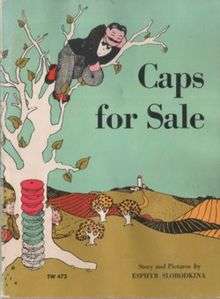Caps for Sale
 The cover of a late edition of Caps for Sale. | |
| Author | Esphyr Slobodkina |
|---|---|
| Illustrator | Esphyr Slobodkina |
| Cover artist | Esphyr Slobodkina |
| Country | United States |
| Language | English |
| Genre | Children's literature |
| Publisher | W. R. Scott |
Publication date | 1940 |
| Media type | |
| Pages | 48 |
| ISBN | 978-0064431439 |
| OCLC | 13008528 |
| Followed by | Pezzo the Peddler and the Circus Elephant (Circus Caps for Sale) |
Caps for Sale: A Tale of a Peddler, Some Monkeys and Their Monkey Business is a children's picture book, written and illustrated by Esphyr Slobodkina and published by W. R. Scott in 1940.[1]
Summary
Based on a folktale, the story follows the life of a mustachioed cap salesman who wears his entire stock of caps on his head; they consist of his own checked cap, then a bunch of green (or gray) caps, a bunch of yellow (or brown) caps, a bunch of blue caps and finally a bunch of red caps on the very top. He strolls through towns and villages chanting, "Caps! Caps for sale! Fifty cents a cap!"[2]
One day, the peddler sits down under a tree to take a nap, with all his wares still on his head. When he awakens, all the caps but his own are gone — stolen by a troop of monkeys, who now sit in the tree wearing them (every monkey has a green (or gray) , a yellow (or brown), a blue, or a red cap). The peddler orders them to return his caps, scolds them, and yells at them, while the monkeys only imitate him. The peddler becomes so angry and he finally throws down his own cap in disgust. However the monkeys throw theirs down as well, right at his feet. He stacks the caps back on his head and strolls back to town, calling, "Caps! Caps for sale! Fifty cents a cap!"[2]
Popularity
It is Slobodkina's best-known work, and has sold more than two million copies.[3] Caps for Sale is a popular read-aloud book, because its repetitive text permits children to speak the lines and thus join in the reading experience.
It won a Lewis Carroll Shelf Award in 1958.[4]
History
The earliest known account of the story may be found The Wilmington Centinel published in Wilmington, North Carolina January 8th, 1789.[5] "According to the following relation from a person just returned from the Labrador coast, the imitative faculty in monkeys seems to exceed every thing short of human. –A sailor having a number of red woolen caps, &c to dispose of among the natives, went on shore for that purpose ; his way to a settlement lying through a woods very copiously inhabited by the species abovementioned, and it being mid day, put a cap on his head, and laying the others by his side, he determined upon a little repose under the shade of a plantain tree. To his utter astonishment, when he awoke, from the specimen he had given his imitative observers of the use of his caps, he beheld a number of them upon the heads of the monkeys on the trees, round about him, while the wearers were chattering in an unusual manner. Finding every attempt to regain them fruitless , he at length in a fit of rage and disappointment, and under the supposition the one he retained was not worth taking away, &c. pulled the same from his head, and throwing it upon the ground exclaimed ---“ here d—n you, take it among ye,” which he had no sooner done, than to his great surprise, the observant monkeys did the same, by which means he regained the greatest part of his property."
References
- ↑ "Caps for sale" (first edition). Library of Congress Online Catalog (catalog.loc.gov). Retrieved 2015-09-27.
- 1 2 Raines, Shirley; Canady, Robert. Story Stretchers: Activities to Expand Children's Favorite Books. p. 158.
- ↑ Goldman, Ari (July 27, 2002). "Esphyr Slobodkina, Artist And Author, Is Dead at 93". Retrieved August 1, 2015.
- ↑ Patrick, Alisha. "ESPHYR SLOBODKINA (1908-2002)". Sullivan Goss. Archived from the original on July 4, 2012.
- ↑ "Bowen and Howard (1789)".